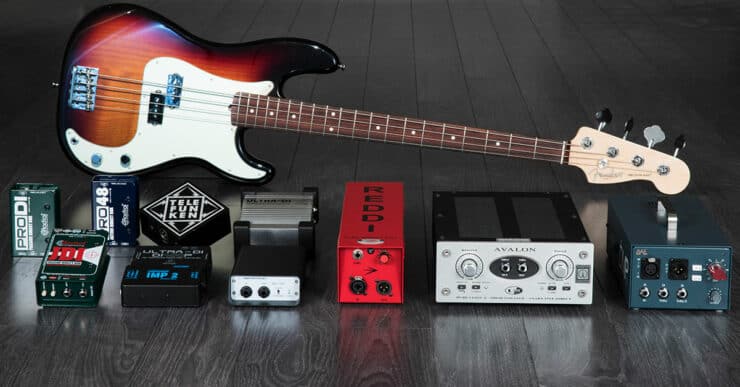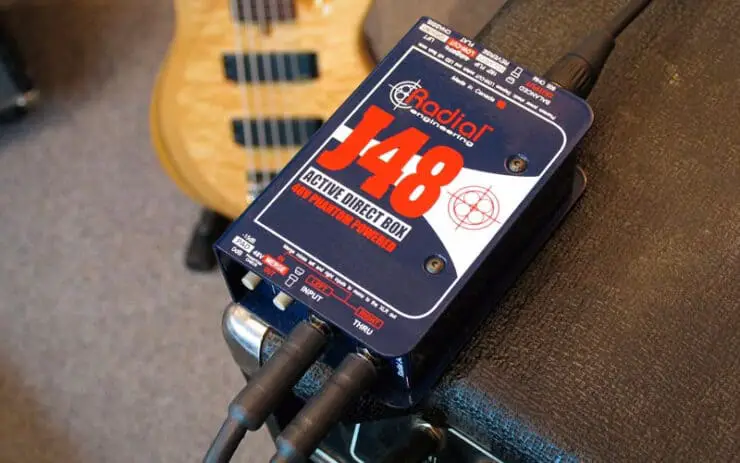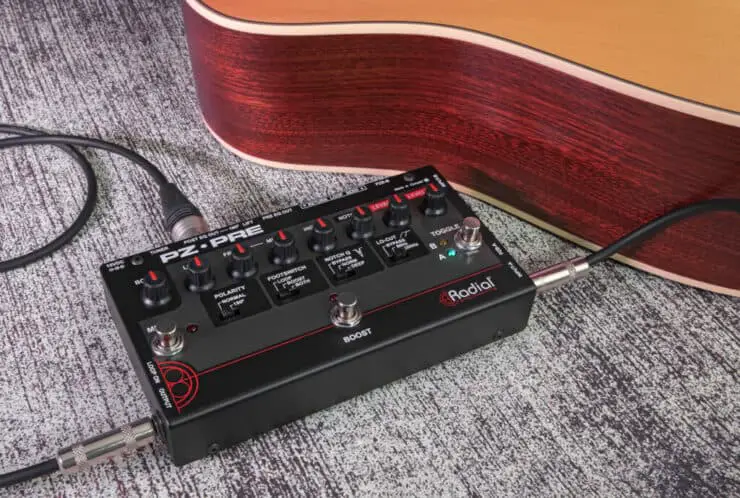Are you a guitar player who wants to get the most out of your instrument’s sound? Are you wondering what is the difference between a guitar preamp and a DI box? Then you have come to the right place! In this article, we will explain the difference between the two and why you should consider having a DI box in your setup. Read on to learn more and to get the most out of your guitar sound!
What is a guitar preamp and how does it work?
A guitar preamp is a vital component in the signal chain of an electric guitar setup. It plays a significant role in shaping the tone and boosting the level of the guitar’s signal before it reaches the power amp or recording device.
It is essentially an electronic device designed for amplifying the low-level signal generated by an electric guitar. It serves as an intermediary between the guitar’s pickups and the power amp or recording device. The primary function of a preamp is to enhance the weak guitar signal, provide tonal shaping capabilities, and prepare the signal for further amplification or recording.
How does a guitar preamp work
To understand how a guitar preamp works, you’ll need to have a closer look at its inner workings and signal flow. This includes a series of steps such as amplification of the signal, tone shaping, signal conditioning, and more.
>>> Click here to read our review about the Top 15 Best Guitar Preamps <<<
When the guitar’s pickups detect the vibrations of the strings, they tend to generate a weak electrical signal. This low-level signal will then be sent to the preamp. The preamp’s first task is to amplify this signal to a more robust level, making it suitable for further processing or amplification. This amplification stage boosts the signal’s voltage and prepares it for the next stage.
Aside from amplifying the signal, an important function of the preamp is to offer tonal shaping capabilities. This can be achieved through the inclusion of different controls and circuitry that allow for adjustments to the frequency responses and overall timbre of the guitar’s sound. The common controls found on guitar preamps include gain or volume, bass, treble, middle, and sometimes additional features like presence or contour controls. These controls will allow you to sculpt your desired tone by boosting or cutting specific frequency ranges.
A guitar preamp might also include additional features for conditioning the signal. These include filters for removing unwanted noise, impedance matching to optimize the interaction between the guitar and the preamp, and effects loops for integrating external effects pedals.
Lastly, there is the output stage. Once the signal has been amplified and shaped, it’ll be sent to the output stage of the preamp. This stage provides a buffered or balanced output signal that is suitable for further processing or transmission. The output can be connected directly to a power amp, a recording device, or other audio equipment depending on the specific application.

Benefits of a guitar preamp
Now that you know how a guitar preamp works, it is also important to find out the benefits guitar preamps offer to musicians and guitarists. Some of the benefits of a guitar preamp include signal boost, tonal control, signal conditioning, and versatility.
The primary benefit of a guitar preamp is to amplify the guitar’s signal, allowing it to reach optimal levels for further amplification or recording. This ensures a strong and robust signal, reducing the chance of noise or interference during the signal chain.
Guitar preamp also provides a range of tone-shaping controls that allow musicians to sculpt their desired sound. The ability to adjust the bass, treble, midrange, and other parameters empowers guitarists to achieve the specific tonal characteristics they desire, whether it is a clean and pristine sound or a heavily distorted tone.
Preamps also include features that help condition the guitar signal. This can involve removing noise or interference, matching the impedance between the guitar and the preamp, or integrating external effects pedals seamlessly into the signal chain.
Guitar preamps come in different types, including tube preamps, solid-state preamps, and digital modeling preamps. This provides musicians with a wide range of sonic options and tonal palettes to choose from. Each type of preamp offers its own unique characteristics, allowing guitarists to explore different tonal flavors and textures.
What is a DI box and how does it work?
In the world of music production and audio engineering, a Direct Injection box or DI box is a versatile device that serves as a bridge between different audio devices and signal sources. It plays an important role in capturing and transforming various signals, providing flexibility, and sonic clarity.
A DI box is an electronic device designed for converting high-impedance, unbalanced signals from instruments or line-level sources into low-impedance, balanced signals that are suitable for connection to professional audio systems, mixers, or recording devices. It serves as an interface between the instrument or audio source and the audio system, allowing for efficient and noise-free signal transmission. The popular DI box brands include Radial and Behringer .
How does a DI box work?
The functionality of a DI box can be easily understood by examining its internal components and signal flow. It follows a number of steps like the input stage, impedance conversion, signal level adjustment, and output stage.
A DI box typically features a high-impedance input designed specifically to accommodate instrument-level signals, such as those produced by electric guitars, bass guitars, keyboards, or other unbalanced sources. The input stage of the DI box matches the impedance of the instrument, delivering an optimal and clean signal transfer.
It also converts the high-impedance, unbalanced signal from the instrument into a low-impedance, balanced signal. This conversion process helps eliminate potential noise and interference, resulting in a cleaner and more robust signal. The balanced signal can be achieved by using a transformer or an electronic circuit within the DI box, which balances the audio signal and provides electrical isolation.
Some DI boxes feature gain control or attenuation switches that allow for signal level adjustment. This feature is useful when dealing with instruments that produce strong or weak signals, ensuring the ideal level for recording or mixing purposes.
The output stage of a DI box will provide a balanced, low-impedance signal that is suited for connection to professional audio systems, mixers, or recording devices. This balanced output will help reject common-mode noises and interference during signal transmission, resulting in a clean and noise-free audio signal.
Benefits of a DI box
Now that you know how a DI box works, it is also important to find out the benefits DI box offers to musicians and guitarists. Some of the benefits of a DI box include signal integrity and clarity, noise reduction, versatility, and more.
One of the primary benefits of using a DI box is its ability to preserve the integrity of the audio signal. By converting the high-impedance, unbalanced signal from an instrument into a low-impedance, balanced signal, a DI box will help minimize signal degradation, noise, and interference. This results in a cleaner and more transparent sound.
DI boxes often incorporate features like ground lift switches, which help in eliminating ground loop hum or interference caused by multiple ground connections. This allows for noise-free signal transmission, especially in situations where the instrument and audio systems are powered by different electrical sources.
A DI box is also valuable when dealing with long cable runs. The low-impedance, balanced signal produced by a DI box is more resistant to noise and signal level over long distances, making it perfect for connecting instruments to audio systems in live sound applications or studio recordings.
DI boxes aren’t limited to instrument-level signals. They can easily handle line-level signals, making them suitable for connecting audio sources like mixers, computers, or media players to professional audio systems. This versatility helps with the seamless integration of various audio sources into a unified system.

What is the difference between a guitar preamp and a DI box?
For musicians, guitarists, and audio engineers, guitar preamps and DI boxes are commonly used tools that serve distinct purposes. While they do share some similarities, it is important to recognize the differences between the two. If you are wondering what is the difference between a guitar preamp and a DI box, then you will find the answers here. Here are the primary differences between guitar preamps and DI boxes.
#1. Inputs and outputs
One of the major differences between a guitar preamp and a DI box lies in their inputs and outputs. A guitar preamp is designed specifically for electric guitars and typically features a high-impedance instrument-level input. This input is optimized for directly connecting guitars or other instruments with similar output characteristics. The output of a guitar preamp is generally a line-level signal, suitable for connecting to power amps, audio interfaces, or other recording devices. Guitar preamps offer additional outputs, such as speaker simulation outputs, or effects loops to cater to specific recording or performance requirements.
Meanwhile, a DI box is more versatile in terms of inputs and outputs. It typically features a combination of inputs, including high-impedance instrument-level inputs, line-level inputs, and microphone-level inputs. This allows for the connection of a wide range of audio sources, such as electric guitars, keyboards, bass guitars, or other line-level devices. The output of a DI box is usually a balanced, low-impedance signal, suitable for connecting to mixers, audio interfaces, or other professional audio systems.
#2. Tone shaping capabilities
Guitar preamps excel in tone-shaping capabilities. They often include dedicated controls for adjusting gain or volume, bass, treble, and middle, as well as additional parameters like presence or contour. These controls allow musicians and guitarists to sculpt their desired tone and add warmth, richness, or presence to their sound. Guitar preamps might also incorporate built-in effects, such as reverb, modulation, or distortion, providing further tonal flexibility.
In contrast, a DI box typically lacks extensive tone shaping controls While some models might also offer basic EQ adjustments or input gain controls, the primary function of a DI box will be to provide a clean and transparent signal transfer. The emphasis is on preserving the integrity of the original source signal instead of altering its tonal characteristics. DI boxes are particularly valuable when capturing the true essence of acoustic instruments or line-level sources without coloration.
#3. Connectivity
Guitar preamps often feature various connectivity options to cater to different recording or performance scenarios. They typically provide outputs for connecting to power amps, audio interfaces, or mixing consoles. Some guitar preamps might also offer direct outputs for recording purposes or send/return loops for integrating external effects pedals. Moreover, certain models might also include speaker simulation outputs, allowing for direct connection to recording devices or PA systems without the need for a separate speaker cabinet.
DI boxes prioritize connectivity and signal transformation. They excel in providing balanced outputs that can be directly connected to mixers, audio interfaces, or recording devices. DI boxes often incorporate features like ground lift switches, which help eliminate ground loop hum or interference in complex audio setups. Further, DI boxes might also include transformer options, allowing for impedance matching and electrical isolation for improved signal integrity.
#4. Function and purpose
A guitar preamp is specifically designed to enhance and shape the signal coming from an electric guitar. It acts as a crucial element in the signal chain, preparing the guitar single for further amplification or recording. The primary purpose of a guitar preamp is to amplify the low-level signal from the guitar’s pickup and provide tonal shaping capabilities. Guitar preamps often include gain controls, EQ knobs, and additional features like presence or contour controls. They allow the guitarist to tailor their sound by adjusting the tonal characteristics and adding coloration or effects to the guitar signal.
Meanwhile, a DI box serves a different purpose than a guitar preamp. Its main function is to convert an unbalanced, high-impedance instrument-level signal into a balanced, low-impedance signal suited for connection to professional audio systems or mixers. DI boxes are commonly used for connecting instruments such as electric guitars, bass guitars, keyboards, or other line-level sources directly to audio interfaces, mixing consoles, or recording devices. They’re designed to preserve the integrity of the original signal without altering its tonal characteristics. DI boxes typically feature impedance matching and electrical isolation to reduce noise and interference in the signal chain.
#5. Versatility
Guitar preamps are primarily used in guitar amp setups, both live and in the studio. They allow guitarists to shape their tone and achieve the desired sound characteristics. Guitar preamps are commonly employed in conjunction with power amps or audio interfaces to provide tonal control and coloration to the guitar signal. They are particularly useful for guitarists who want to explore different sonic possibilities to experiment with various amplifier models and effects.
DI boxes are extremely versatile tools suitable for a wide range of amplifications beyond just guitar amplification. They are commonly used in live sound setups, recording studios, and professional audio environments. DI boxes are important for connecting instruments such as electric guitars, bass guitars, keyboards, or other line-level sources directly to audio systems or mixers. They are also useful for capturing the clean and balanced signals of acoustic instruments or integrating various audio sources into a unified system.
When to use a guitar preamp vs a DI box
When it comes to live performances and recording sessions, selecting the right tools for capturing and shaping guitar signals will be important. Two commonly used devices used by musicians and guitarists are the guitar preamp and the DI box. Understanding when to use each device can greatly impact the quality and versatility of your sound. Here are the different scenarios when you should use a guitar preamp and a DI box –
Live performances
A guitar preamp is often the preferred choice for live performances when using a traditional guitar amp setup. Here are situations when a guitar preamp shines –
If you want to replicate the sound of a specific amp model or create your signature tone, a guitar preamp with amplifier modeling capabilities will be the way to go. It will allow you to achieve various amp sounds without the need for multiple physical amps.
Guitar preamps offer extensive tone-shaping controls, such as EQ knobs, gain adjustments, and built-in effects. These features allow you to sculpt your tone, add coloration, and apply effects like delay, reverb, or distortion to your sound.
If you’re using an extensive pedalboard setup with various effects pedals, a guitar preamp will allow you to integrate them seamlessly into your signal chain. The preamp will act as a central hub, ensuring optimal signal routing and control over your entire setup.

While guitar preamps definitely excel in live performance scenarios, DI boxes also have their place. There are also situations when you may choose to use a DI box for live performances –
If you prefer a direct connection from your guitar to the front-of-house mixer or PA system, bypassing the guitar amp, a DI box will be important. It will allow you to send a balanced, low-impedance signal directly to the mixer, ensuring clarity and signal integrity.
DI boxes can often feature ground lift switches that help eliminate ground loop hum or interference caused by multiple ground connections in complex audio setups. This feature is especially valuable in live performances when noise reduction is important.
If you have to cover significant distances between the stage and the mixing console, a DI box with balanced outputs will be the ideal option. Balanced signals are less susceptible to noise and signal degradation over long cable runs, ensuring you get a clean and reliable signal transmission.
Recording
When it comes to recording electric guitars, a guitar preamp offers a great deal of versatility and tone control. Many people prefer using a guitar preamp in the recording studio for reasons such as –
Guitar preamps offer a wide range of tonal options, allowing you to shape and customize your guitar sound to fit the recording context. The ability to adjust gain, EQ, and other parameters will ensure that you’re able to capture the desired tone with precision.
If you’re looking to record with specific effects applied directly to your guitar sound, a guitar preamp with built-in effects or effects loop capabilities will allow for easy integration. This will ensure that your effects are captured accurately during the recording process.
While a guitar preamp is definitely a popular choice for recording electric guitars, there are instances where a DI box is better suited –
When recording acoustic guitars, violins, mandolins, or other acoustic instruments, a DI box is often the better option. It captures the clean, unaltered sound of the instrument, preserving its natural acoustic characteristics.
If you are recording keyboardists, synthesizers, drum machines, or other line-level sources, a DI box will allow for seamless integration into the recording setup. It converts the line-level signal into a balanced, low-impedance signal that is compatible with audio interfaces and mixing consoles.
When a clean and transparent signal capture is desired, such as for re-amping or post-processing flexibility, a DI box delivers a direct and uncolored signal. This will allow for more flexibility during the mixing and mastering stages as the tonal characteristics can be adjusted later.
FAQs
What is the main difference between a guitar preamp and a DI box?
A guitar preamp is used to boost and shape the guitar signal before it is sent to an amplifier or recording device. A DI box (direct injection) is used to connect the guitar to a mixing board or other recording device. A guitar preamp is typically located between the guitar and the amplifier, while a DI box is typically located between the guitar and the recording device.
What are the benefits of using a guitar preamp?
Using a guitar preamp can help to improve the sound of your guitar by adding clarity, warmth, and increased dynamic range. Preamps also offer control over tone and volume, allowing for more precise control over the sound of the guitar.
What are the benefits of using a DI box?
DI boxes are useful for connecting a guitar to a mixing board or other recording device, as they help to reduce noise and hum while also providing balanced output. DI boxes also allow you to send the signal directly to a recording device, allowing for quick and easy recording without the need for an amplifier.




